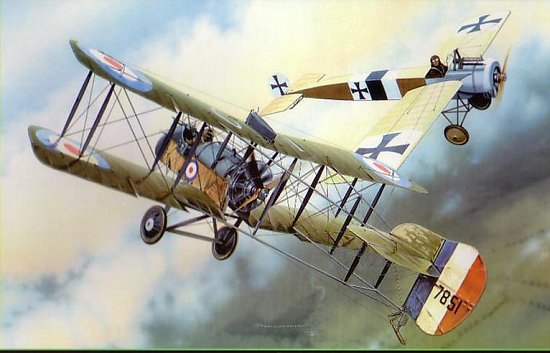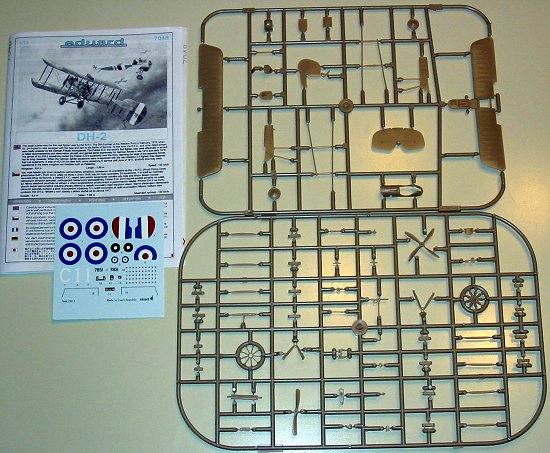
|
KIT: |
Eduard 1/72 Airco DH-2 |
|
KIT # |
7048 |
|
PRICE: |
$18.99 |
|
DECALS: |
Two Aircraft |
|
REVIEWER: |
Bill Michaels |
|
NOTES: |
Much nicer than the old Revell Kit |

|
HISTORY |
Geoffrey DeHavilland’s first design to be produced was the DH-1. This was a two seat pusher biplane, with the gunner seated in front of the pilot. Lack of a suitable powerplant kept the design from being a success, however.
In early summer of 1915, the DH-2 prototype took to the air with DeHavilland at the controls. The aircraft was a single seat, pusher biplane, with a good field of fire and view for the pilot. The aircraft’s performance was good compared to its contemporaries, and the design was put into production in the late fall of 1915.
The DH-2 had a single Lewis gun, on a flexible telescoping mount. In theory, the pilot could aim the gun through a fairly wide field of fire. In practice, however, most pilots found aiming the gun while also trying to fly the aircraft to be too much to handle. As a result, the gun was typically fixed in position to fire straight ahead.
At the same time that the DH-2 prototype was taking to the air, the Fokker Eindeckers were making their presence felt in the skies over France. The “Fokker Scourge” gave Germany air superiority over the battlefields of France in the first half of 1916.
Britain’s first fighter squadrons were formed with DH-2 aircraft in the spring of 1916. This marked the start of the DH-2’s greatest success, as it outclassed the Fokker monoplanes. During the summer of 1916, the DH-2 was the dominant fighter over the Western Front.
In early fall, the Germans started to deploy newer, better aircraft. Halberstadts and Albatross fighters began to arrive at the front. The Albatross D.1 was a tough adversary—it was faster, and had twin gun armament to the DH-2’s single Lewis gun. The DH-2 could out-turn the Albatross, but the German fighter had the significant advantage of being able to use its superior speed and climbing ability to enter and break off combat at will.
At first, the more experienced British pilots were able to negate the advantage the German biplanes had, but that advantage ebbed away as the German pilots and tactics improved.
On November 23, 1916, Major Lanoe Hawker, CO of 24 Squadron, was flying DH-2 5964, when he engaged in an epic dogfight with a young German Lieutenant. It was a battle of skilled pilots—every time the German had the DH-2 under his guns, Major Hawker would maneuver away. However, the DH-2 was over enemy territory and running low on fuel. Eventually, Hawker had to break for home, and he was unable to escape the faster Albatross aircraft. Major Hawker was killed in what was Manfred Von Richtofen’s 11th victory.
The DH-2’s day was clearly past. By summer of 1917 they had been replaced by newer aircraft in the squadrons on the Western Front. They did continue to serve with some success in the Balkans and the Middle East into the summer of 1918. In all, 401 DH-2s were produced.
|
THE KIT |

The kit, molded in tan, consists of two sprues of parts, a set of masks for painting, and a decal sheet. It comes in a big, sturdy box—the box is the same size as some of the Eduard 1/48 scale kits. But this is not a case of an un-necessarily large box—the kit’s two large sprues are a tight fit, so they don’t slide around.
My model had very clean moldings— no signs of mis-alignment, and no flash. Trailing edges seem to be pretty fine, too. Control horns are molded in to the control surfaces. The rudder and elevator could easily be removed and repositioned. The fine detail of the hinges will make it more of a challenge to do the ailerons, though.
The fabric detail is very well done. The model does not have the “ridge and valley” effect many older kits have. The flying surfaces also do not have any weave or fabric detailing, which is appropriate for this scale. The weave of the fabric does not belong on a model in 1/72 scale.
The cockpit looks to be very well done. Detail includes a seat, control stick, rudder pedals, sidewall moldings, and instrument panel. A nice Lewis gun and mounting complete the area. There is no pilot figure included in the kit. There are no clear parts, either. The instructions show the location and size of the windscreen, and tell you to make it from “foil”. (I suspect that this is a translation error.)
The instructions are the typical pictorial style, with warnings and color definitions in five different languages. The instructions are very complete, and include painting instructions. The painting instructions include the use of the supplied masks. The instructions also include five different diagrams showing how to completely rig the model with both fixed rigging and control cables. The instructions end with two separate three views for both versions of the plane, showing colors and decal placement.
There are decals for two RAF aircraft. The first is for an aircraft (s/n 7851) from “C” Flight of No. 32 Squadron, with the standard PC-10 green over clear doped linen (CDL) color scheme. This aircraft served for about 6 months, before being shot down on January 7, 1917. This aircraft’s claim to fame seems to be that it is the cover illustration for the Windsock Datafile on the DH-2. There are a couple of pictures of 7851 in the Datafile. One of the pictures clearly shows that this plane had a faded roundel on the underside of the top port wing. This means that at some point, this wing had been replaced with one that had previously been used as a bottom wing. (The wings were interchangeable.) An extra wing decal is provided for this, but it will need some work to get the necessary faded look. The other set of markings is for an un-identified aircraft from No. 14 Squadron in Palestine in 1917. This aircraft is finished in CDL all over.
The decals look nice and thin, and my copy were printed in register. The decal sheet is very nice. The rudder stripes and aircraft serial number are separate decals, so you can use the stripes and add your own numbers to make any aircraft you may want. (I wish all WW1 decal sheets had the serial numbers and/or manufacturer logos as separate decals from the background!) Other nice touches include good looking instrument panel decals, and decals to represent the fuselage stitching.
|
CONCLUSIONS |
Highly recommended. This looks like an excellent kit. Clean moldings, excellent instructions, great decals, and a painting mask all add up to what looks like a super kit.
The model is big improvement over the 1965 Revell kit. The only thing I can find to complain about is that I wished they had included decals for a more historically significant aircraft. (The Revell kit includes the marking for Lanoe Hawker’s aircraft.)
This kit is in my “I want to build it soon” pile.
Review kit courtesy of my wallet. (June 2003)
|
REFERENCES |
Airco DH2 (Windsock Datafile 48), by B.J. Gray, Albatross Publications, Berkhamsted, Hertfordshire., 1994.
Richtofen: A True History of the Red Baron by William E. Burrows, Harcourt, Brace,& World; New York, 1969.
If you would like your product reviewed fairly and quickly by a site that has over 200,000 visitors a month, please contact me or see other details in the Note to Contributors.